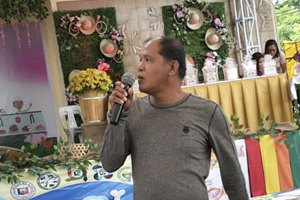 Three goat farmers from Balungao, Pangasinan shared their success stories during the Farms and Industry Encounters through the Science and Technology Agenda (FIESTA) for Goat held on April 25-26, 2019 at Baler, Aurora.
Three goat farmers from Balungao, Pangasinan shared their success stories during the Farms and Industry Encounters through the Science and Technology Agenda (FIESTA) for Goat held on April 25-26, 2019 at Baler, Aurora.
The FIESTA was conducted by the Central Luzon Agriculture, Aquatic and Natural Resources Research and Development Consortium (CLAARRDEC), one of the 16 consortia under the Philippine Council for Agriculture, Aquatic and Natural Resources Research and Development of the Department of Science and Technology (DOST-PCAARRD).
The testimonies of success of Samuel J. Sardenia, 70 years old; Nuevo M. Villanueva, 61 years old; and Ciriaco B. Soriano, 52 years old, converged on one point – their adoption of learnings from the Farmers Livestock School on Goat Enterprise Management (FLS-GEM). The said farmers are from Balungao, Pangasinan.
Sardenia, Villanueva, and Soriano are graduates of FLS-GEM, a participatory training approach for livestock farmers.
FLS-GEM enables a farmer to create a basket-full of production and enterprise management options that best suit his capacity.
Sardenia shared his sucess story on the rise of his goat business from upgrading; Villanueva on his 'paiwi' system; and Soriano on his grazing meat goats for slaughter.
“With FLS-GEM, I was able to upgrade my goats. They now have higher body weight. I can sell them for P5,000.00 each at its lowest selling price after 6-8 months and for P10,000.00 after a year at its highest selling price,” Sardenia said.
 Sardenia was the champion of the Balungao Goat Festival for having produced the best buck and doe in 2016.
Sardenia was the champion of the Balungao Goat Festival for having produced the best buck and doe in 2016.
Meanwhile, Villanueva testified that his Anglo Nubian, Boer, and upgraded goats could weigh 20 kilograms (kg) after six months and 30-35 kg at 12 months compared with 10 and 20 kg of the native breed raised within the same period of time.
With the growing number of his goats, Villanueva has to raise some of them through the paiwi system. It lessens the required labor and it also provides the neighborhood with additional income.
“More than these advantages, the paiwi system establishes better relationship between me and my community,” Villanueva said.
For his part, Soriano explained the benefits of improved science-based goat health management, which focused on the feeding of goats with available forages, napier, and native grasses. He also advised the production of these shrubs and legumes to ensure supply.
